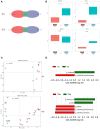Clinical Study of Correlation for the Intestinal and Pharyngeal Microbiota in the Premature Neonates
- PMID: 33665178
- PMCID: PMC7920978
- DOI: 10.3389/fped.2021.632573
Clinical Study of Correlation for the Intestinal and Pharyngeal Microbiota in the Premature Neonates
Abstract
Objective: There are mutual influences between intestine and lung, that propose a concept of the gut-lung axis, but the mechanism is still unclear. Microbial colonization in early life plays an important role in regulating intestinal and lung function. In order to explore the characteristics of early microbiota on the gut-lung axis, we studied the correlation between intestinal and pharyngeal microbiota on day 1 and day 28 after birth in premature neonates. Methods: Thirteen neonates born at 26-32 weeks gestational age (GA) hospitalized at the neonatal intensive care unit (NICU) of the West China Second Hospital of Sichuan University were enrolled in this study. Stool samples and pharyngeal swabs samples were collected from each neonate on the first day (T1) and the 28th day (T28) after birth. Total bacterial DNA was extracted and sequenced using the Illumina MiSeq Sequencing System based on the V3-V4 hyper-variable regions of the 16S rRNA gene. Based on the sequencing results, the composition of the intestinal and pharyngeal microbiota was compared and analyzed. Results: At T1, the difference in microbial composition between intestine and pharynx was not statistically significant. The intestinal microbiota was mainly composed of Unidentified Enterobacteriaceae, Ralstonia, Streptococcus, Fusobacterium, Ureaplasma, etc. The pharyngeal microbiota was mainly composed of Ureaplasma, Bacteroides, Fusobacterium, etc. Ureaplasma and Fusobacterium were detected in both intestine and pharynx. At T28, there was a significant difference in microbial composition between intestine and pharynx (p < 0.001). The intestinal microbiota was mainly composed of Unidentified Clostridiales, Klebsiella, Unidentified Enterobacteriaceae, Enterobacter, Streptococcus, etc. Pharyngeal microbiota was mainly composed of Streptococcus, Rothia, etc. Streptococcus was detected in both intestine and pharynx. Conclusions: The intestine and pharynx of premature neonates have a unique microbial composition, and share some common microbiota. Whether these microbiotas play a role in the mechanism of gut-lung crosstalk needs further study.
Keywords: 16S rRNA sequencing; gut-lung axis; intestinal micriobiota; pharyngeal microbiota; preterm neonate.
Copyright © 2021 Yang, Qiao, Shi, Xie, Liu, Xiong and Liu.
Conflict of interest statement
The authors declare that the research was conducted in the absence of any commercial or financial relationships that could be construed as a potential conflict of interest.
Figures


Similar articles
-
The correlation of the intestinal with pharyngeal microbiota in early neonates.Front Microbiol. 2023 Aug 3;14:1225352. doi: 10.3389/fmicb.2023.1225352. eCollection 2023. Front Microbiol. 2023. PMID: 37601350 Free PMC article.
-
Comparison of intestinal and pharyngeal microbiota in preterm infants on the first day of life and the characteristics of pharyngeal microbiota in infants delivered by cesarean section or vaginally.Front Pediatr. 2024 Oct 8;12:1411887. doi: 10.3389/fped.2024.1411887. eCollection 2024. Front Pediatr. 2024. PMID: 39439450 Free PMC article.
-
Characteristics of intestinal microbiota in preterm infants and the effects of probiotic supplementation on the microbiota.Front Microbiol. 2024 Mar 7;15:1339422. doi: 10.3389/fmicb.2024.1339422. eCollection 2024. Front Microbiol. 2024. PMID: 38516015 Free PMC article.
-
[Intestinal and pharyngeal microbiota in early neonates: an analysis based on high-throughput sequencing].Zhongguo Dang Dai Er Ke Za Zhi. 2023 May 15;25(5):508-515. doi: 10.7499/j.issn.1008-8830.2301015. Zhongguo Dang Dai Er Ke Za Zhi. 2023. PMID: 37272178 Free PMC article. Chinese.
-
Trends and determinants of gastric bacterial colonization of preterm neonates in a NICU setting.PLoS One. 2015 Jul 1;10(7):e0114664. doi: 10.1371/journal.pone.0114664. eCollection 2015. PLoS One. 2015. PMID: 26132213 Free PMC article.
Cited by
-
The correlation of the intestinal with pharyngeal microbiota in early neonates.Front Microbiol. 2023 Aug 3;14:1225352. doi: 10.3389/fmicb.2023.1225352. eCollection 2023. Front Microbiol. 2023. PMID: 37601350 Free PMC article.
-
Deleterious Effect of Air Pollution on Human Microbial Community and Bacterial Flora: A Short Review.Int J Environ Res Public Health. 2022 Nov 22;19(23):15494. doi: 10.3390/ijerph192315494. Int J Environ Res Public Health. 2022. PMID: 36497569 Free PMC article. Review.
-
Comparison of intestinal and pharyngeal microbiota in preterm infants on the first day of life and the characteristics of pharyngeal microbiota in infants delivered by cesarean section or vaginally.Front Pediatr. 2024 Oct 8;12:1411887. doi: 10.3389/fped.2024.1411887. eCollection 2024. Front Pediatr. 2024. PMID: 39439450 Free PMC article.
-
Characteristics of intestinal microbiota in preterm infants and the effects of probiotic supplementation on the microbiota.Front Microbiol. 2024 Mar 7;15:1339422. doi: 10.3389/fmicb.2024.1339422. eCollection 2024. Front Microbiol. 2024. PMID: 38516015 Free PMC article.
-
[Intestinal and pharyngeal microbiota in early neonates: an analysis based on high-throughput sequencing].Zhongguo Dang Dai Er Ke Za Zhi. 2023 May 15;25(5):508-515. doi: 10.7499/j.issn.1008-8830.2301015. Zhongguo Dang Dai Er Ke Za Zhi. 2023. PMID: 37272178 Free PMC article. Chinese.
References
LinkOut - more resources
Full Text Sources
Other Literature Sources

